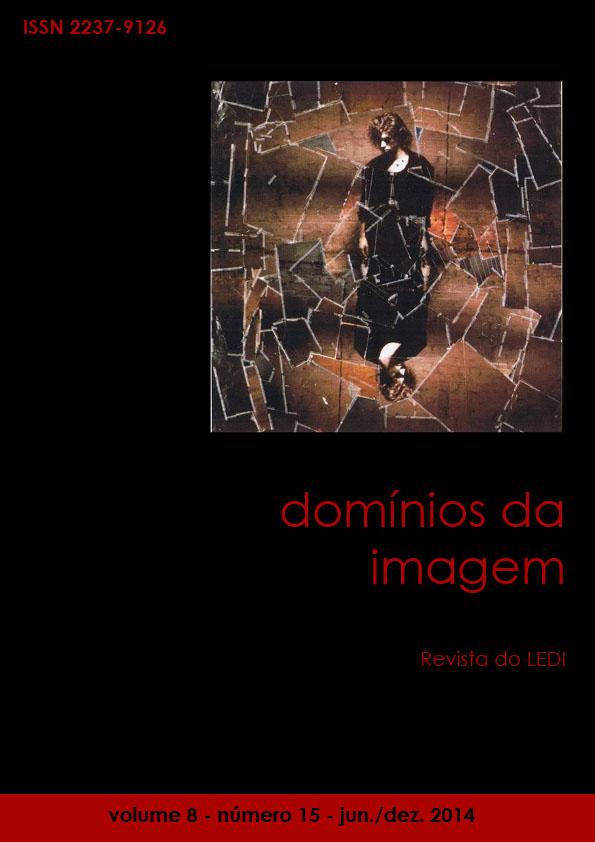Aparências que contam: a aparência como ferramenta de avaliação social
DOI:
https://doi.org/10.5433/2237-9126.2014v8n15p5Palavras-chave:
Aparência, Fotografia, Média.Resumo
O artigo explora a forma como, na modernidade, desenvolveu-se a crença numa relação de causa e efeito entre o carácter e a aparência dos indivíduos. Várias foram as personalidades que tentaram tornar positivas as investigações e a catalogação das aparências, tendo-se desenvolvido metodologias de análise e arquivos de imagens que tentavam estabelecer critérios de identificação de aparências de sujeitos ditos “desajustados”. A fotografia desempenhou papel de relevo na criação destes arquivos, permitindo tornar objectivas determinadas encenações. Como forma de tornar mensurável a normalidade, estabeleceu-se a figura do “homem-médio”, na qual média e ideal se sobrepõem. Aborda-se o papel da figura da média ou ideal na Europa moderna e, igualmente, na emergência da sociedade de consumo norte-americana.
Métricas
Referências
BAIN NEWS SERVICE. Portrait Parle class. France. [191?]. Disponível em: https://www.flickr.com/photos/library_of_congress/2162889173/in/photolistic99Ln-9rriV8-4i8nAD-hNYegr-9ruhdj-pNVJX-4i8nFk-hTJCMH-nVmpJJ-4hQbj4- 4hUgmq-icaXSf-ic8mxR-hTLPg7-ic9Meq-ic7NVL-ic6AJS-ic6ivU-ic5fri-icaFzpic7BhT-i1vrDN-dSxbFz-ic5KYK-hTSYwr-icaZh8-hTLzbm-hTRScz-8D7j5j-icccTQiccjRM-icc56A-icbUzS-icbTJo-icbZtP-icbnJA-icbeZ7-icbuzB-icaYHo-ic9q3h-ic9iyd-ic95aE-ic8Du9-ic8b9Y-ic8ePG-ic7HTv-ic7B61-ic6WDH-ic7aGh-ic6QW9. Acesso em: 4 jul. 2014.
BATAILLE, Georges. The deviations of nature. In: BATAILLE, Georges.. Visions of excess: selected writings 1927-1939. Minneapolis: University of Minnesota Press, 1985.
BAUMAN, Zygmunt. Life in fragments: essays in postmodern morality. Cambridge: Blackwell, 1995.
BETTY CROCKER. New! Custard chiffon cake. Family Circle, v. 43, n. 1, July 1953. Disponível em:https://www.flickr.com/photos/29069717@N02/10320281363/in/photolistgHY96z-8gLofS-7hbpDW-7h7r9X-3EfAvA-go4r3b-q2pBo-gfyA4Z-5Nt2wR5wgCaX-49Js84-jrC1eN-kAQWCD-3Kgn1i-jrA3JP-5wgCfg-7hbpgC-nB7atA6XwvQT-hDwnRZ-gCuaLX-5Nt2ye-mKgUef-6dPwaR-kB9KAc-aoeqYK-8kX89ghWPGYd-aE62TC-dPuuZ8-49Jsbx-kg8Ce-iVSzg-ady1jA-ggpMYy-fhXpat-fhXpkXfhXpeP-fhXpcP-ficEJh-ficEDb-ficEFS-ficELq-fhXpjn-fhXpe6-ficEAY-48VMwE3EbieK-74pvv9-74hjde. Acesso em: 4 jul. 2014.
COURTINE, Jean-Jacques; HAROCHE, Claudine. História do rosto. Lisboa: Teorema, 1995.
DELEUZE, Gilles; GUATTARI, Félix. Mil planaltos: capitalismo e esquizofrenia. 2. ed. Lisboa: Assírio & Alvim, 2007.
DELEUZE, Gilles. O mistério de ariana. Lisboa: Veja, 1996.
DIDI-HUBERMAN, Georges. Invention of hysteria: charcot and the iconography of the salpêtrière. Massachusetts: The mit press, 2003.
FOUCAULT, Michel. Abnormal: lectures at the college de france 1974-1975. New York: Picador, 1999.
FOUCAULT, Michel. História da sexualidade I: a vontade de saber. Lisboa: Relógio d´Água, 1994.
FRADE, Pedro Miguel. Figuras do espanto: a fotografia antes da sua cultura. Lisboa: Asa, 1992.
GALTON, Francis. Race improvement. In: CANDICANS, Galtonia. Memories of my life. London: Nabu press, 1909. p. 310-324.
GILMAN, Sander L. Making the body beautiful: a cultural history of aesthetic surgery. Princeton: Princeton University Press, 1999.
HABERMAS, Jürgen. Técnica e ciência como ideologia. Lisboa: Edições 70, 2007.
LAVATER, Johann Caspar. Johan Caspar Lavater, rejse til danmark i sommeren 1793. 1898. Disponível em: https://www.flickr.com/photos/britishlibrary/11247426564/in/photolist-nnFPo5- 4LzBrv-aCNTpy-7AMemd-bX9Wer-5PDpLz-cdAtGW-a1ETdp-aCNSN5-aCL9TaaCL96a-9vvdR9-ax1ZcU-i8U14E-i8NkjB-md1Lh-6a12rP-2iPcXX-5toR65-axUpWDaxUpjx-8BsS12-bunk7w-8k1ecA-mbVF4E-8jXbsz-8jWTZD-d1Uwu5-iBofhJ-5xa272- 7dqnBG-8kzj5K-92q8BU-FbxmX-92n2ak-9TLbQT-9TXydX-9To8Xt-9TP17W-9U6uZu9Tnkb6-9Tr62A-9TXTj2-9T6KA4-9Ta3uj-4wJVXw-8dYwvk-92q8zh-92q8xd-8XW6oj. Acesso em: 4 jul. 2014.
LAVATER, Johann Caspar. On the lines of animality. In: LAVATER, Johann Caspar. Essays on physiognomy: for the promotion of knowledge and the love of mankind. London: C. Whittingilam, 1804. p. 493. v. 3.
LAVATER, Johann Caspar. Physiognomy, or the corresponding analogy between the conformation of the features and the ruling passions of the mind. London: William Tegg, 1866.
MEIJER, Miriam. Race and aesthetics in the anthropology of petrus camper. Amsterdam: Rodopi, 1999.
PLINE L´ANCIEN. Histoire naturelle XXXV. Paris: Les belles lettres, 1985.
QUETELET, Adolphe. A treatise on man and the development of his faculties. Los Angeles: University of California Library, 2003.
SHAPIRO, Laura. “I guarantee”: betty crocker and the woman in the kitchen. In: AVAKIAN, Arlene V.; HABER, Barbara (Ed.). From betty crocker to feminist food studies: critical perspectives on woman and food. Boston: University of Massachusetts Press, 2005.
STOICHITA, Victor. A short history of the shadow. London: Reaktion books, 1999.











 As obras deste periódico estão licenciadas com
As obras deste periódico estão licenciadas com 